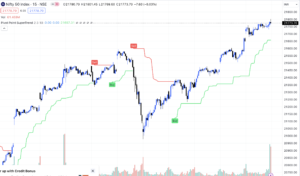Elder Impulse System: A Simplified Guide to Trading [ Free Indicator ]

In the competitive realm of stock trading, staying ahead of the curve is essential for success. Dr. Alexander Elder’s Elder Impulse System has emerged as a powerful yet user-friendly tool for traders seeking clarity in market trends. In this post, we’ll demystify the Elder Impulse System, offering an accessible guide for traders at all levels.
Understanding the Elder Impulse System
The Elder Impulse System simplifies stock market analysis by leveraging three key indicators: Moving Averages (MA), Moving Average Convergence Divergence (MACD), and Bulls/Bears Power. Let’s break down these components and explore how they contribute to the system’s effectiveness.
- Moving Average (MA):
- The Elder Impulse System employs the 13-day Exponential Moving Average (EMA) and the 34-day EMA to smoothen stock price fluctuations.
- MACD (Moving Average Convergence Divergence):
- MACD, with its MACD line and Signal line, gauges stock momentum. A bullish trend is signaled when the MACD line crosses above the Signal line, while a bearish trend is indicated by the opposite crossover.
- Bulls/Bears Power:
- Measuring the strength of buyers and sellers, Bulls/Bears Power calculates the difference between the highest and lowest prices and the 13-day EMA.
Here is the link to redesigned version of Elder Impulse System on tradingview
- Measuring the strength of buyers and sellers, Bulls/Bears Power calculates the difference between the highest and lowest prices and the 13-day EMA.
Deciphering Elder Impulse System Signals
The Elder Impulse System streamlines decision-making by translating intricate market data into three distinct signals:
- Bullish Signal (Green):
- The 13-day EMA surpasses the 34-day EMA.
- The MACD line crosses above the Signal line.
- Bulls Power registers as positive.
A green bar signifies a bullish signal, indicating a potential uptrend and prompting traders to consider buying or holding positions.
- Bearish Signal (Red):
- The 13-day EMA falls below the 34-day EMA.
- The MACD line crosses below the Signal line.
- Bears Power is negative.
A red bar denotes a bearish signal, signaling a possible downtrend and suggesting traders consider selling or adopting a defensive stance.
- Neutral Signal (Gray):
- In the absence of clear bullish or bearish indicators, a neutral signal is generated.
- This may occur during market consolidation or uncertainty, indicating a lack of a definitive trend.
Applying the Elder Impulse System for Trading
- Simplicity Wins:
- The Elder Impulse System’s simplicity makes it accessible for traders of all levels, aligning with Google’s preference for user-friendly content.
- Trend Identification Strategies:
- Insight into trend identification aligns with popular search queries. Traders seeking effective strategies will find value in the Elder Impulse System.
- Risk Management Techniques:
- Incorporating risk management concepts into the discussion appeals to traders seeking ways to optimize their trading approach.
In the fast-paced world of stock trading, the Elder Impulse System emerges as a beacon of simplicity and effectiveness. By integrating Moving Averages, MACD, and Bulls/Bears Power, this system equips traders with clear signals, empowering them to make informed decisions. Whether you’re a seasoned investor or just starting, consider adding the Elder Impulse System to your toolkit for a strategic advantage in the ever-evolving stock market landscape. Master the art of stock trading with this comprehensive guide to the Elder Impulse System.





